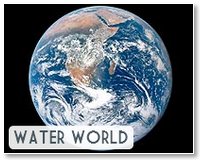| . |  |
. |
Vancouver, Canada (SPX) Jan 27, 2011 University of British Columbia researchers have produced the first map of the world outlining the ease of fluid flow through the planet's porous surface rocks and sediments. The maps and data, published in Geophysical Research Letters, could help improve water resource management and climate modelling, and eventually lead to new insights into a range of geological processes. "This is the first global-scale picture of near-surface permeability, and is based on rock type data at greater depths than previous mapping," says Tom Gleeson, a postdoctoral researcher with the Department of Earth and Ocean Sciences. Using recent world-wide lithology (rock type) results from researchers at the University of Hamburg and Utrecht University in the Netherlands, Gleeson was able to map permeability across the globe to depths of approximately 100 metres. Typical permeability maps have only dealt with the top one to two metres of soil, and only across smaller areas. "Climate models generally do not include groundwater or the sediments and rocks below shallow soils," says Gleeson. "Using our permeability data and maps we can now evaluate sustainable groundwater resources as well as the impact of groundwater on past, current and future climate at the global scale." A better understanding of large scale permeability of rock and sediment is critical for water resource management--groundwater represents approximately 99 per cent of the fresh, unfrozen water on earth. Groundwater also feeds surface water bodies and moistens the root zone of terrestrial plants. "This is really an example of mapping research from a new, modern era of cartography," says Gleeson. "We've mapped the world, peering well below the surface, without ever leaving our offices." The study's maps include a global map at a resolution of 13,000 kilometres squared, and a much more detailed North American map at a resolution of 75 kilometres squared. The research also improves on previous permeability databases by compiling regional-scale hydrogeological models from a variety of settings instead of relying on permeability data from small areas. The paper's authors include UBC Professors Leslie Smith and Mark Jellinek, as well as researchers from the US Geological Survey in Denver, Colorado, the University of Hamburg, and Utrecht University.
Share This Article With Planet Earth
Related Links University of British Columbia Water News - Science, Technology and Politics
 China earmarks $303 bn for safe water: report
China earmarks $303 bn for safe water: reportBeijing (AFP) Jan 21, 2011 China plans to invest $303 billion in water infrastructure projects over the next five years that would give millions of rural residents access to safe drinking water, state media reported. Severe flooding and droughts across the country last year destroyed crops and drove up food prices, pushing inflation to its highest level in more than two years, prompting the investment. Beijing wil ... read more |
|
| The content herein, unless otherwise known to be public domain, are Copyright 1995-2010 - SpaceDaily. AFP and UPI Wire Stories are copyright Agence France-Presse and United Press International. ESA Portal Reports are copyright European Space Agency. All NASA sourced material is public domain. Additional copyrights may apply in whole or part to other bona fide parties. Advertising does not imply endorsement,agreement or approval of any opinions, statements or information provided by SpaceDaily on any Web page published or hosted by SpaceDaily. Privacy Statement |